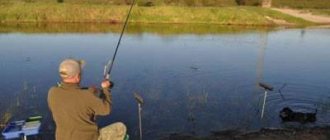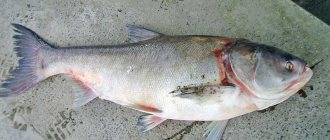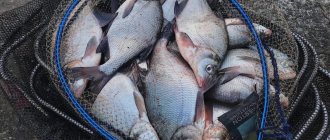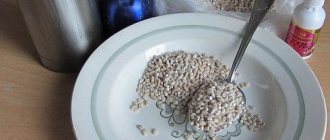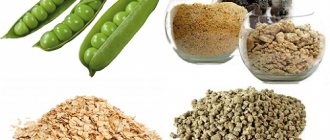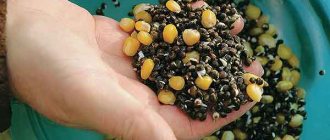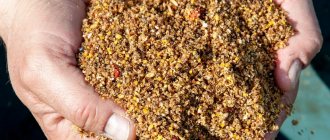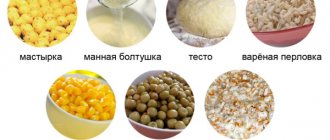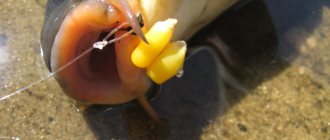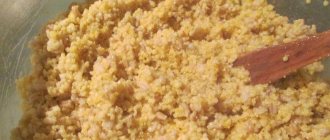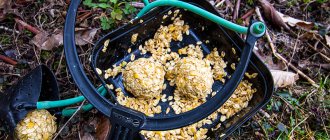Benefits of Salapin porridge
The key property of salapinka is that, in addition to finely dispersed components, one of the components is pearl barley, which is important for attracting large fish, since small ones are not able to swallow it.
Ready-made bait mixtures generally have a finely dispersed structure if they have an impressive odor. When it comes into contact with water, a cloud of turbidity appears, which arouses the fish's interest. But after it dissipates, the fish leaves the fishing spot if it doesn’t like the bait.
Salapin porridge performs the main tasks of bait, such as attracting fish and keeping it at the casting point, one hundred percent. In addition, it is able to provide long-term uninterrupted feeding, due to the fact that large components do not disintegrate immediately.
Other advantages of such porridge in comparison with ready-made bait:
- full control over the quality and freshness of ingredients;
- ease of preparation and availability of ingredients;
- ease of use, as you can take bait in any quantity.
Salapinskaya porridge for bream feeder
Thanks to such nourishing elements, fish can stay in the same area for a certain period of time. Large bream is suitable for smell, in addition, it is a rather curious fish, so it may be interested in the cloud of turbidity or silt that rises from the bottom when casting the feeder.
In the absence of large and, therefore, satisfying fractions, large fish will understand that there is nothing to profit from here, and will go home. If the goal is to catch a large bream, then for feeding you need to use only homemade Salapin porridge.
This kind of bait functions in the following way: you fill the feeder with it and throw it into the area where the fish should approximately be located. Then it acts independently - the porridge is gradually washed out of the feeder, and an attractive smell emanates from it. This is what attracts the fish. Small particles (usually these include corn grits and eggs) can initially attract small fish, but gradually larger specimens will also approach, which prefer steamed millet and pearl barley.
It is worth noting that it is Salapin porridge that is the most effective bait in the case of bream - no other bait works this way, even the recently popular bait from foreign manufacturers.
Some experienced fishermen sometimes alternate Salapin porridge with purchased baits or with so-called “dusting” baits. They also contain a small amount of large particles, which, scattering in the water column, attract a lot of fish.
Ingredients of classic Salapin porridge
You will need simple and inexpensive ingredients that are sold in any grocery store:
- pearl barley – 1 part;
- barley groats – 2 parts;
- corn grits – 3 parts;
- millet – 2 parts;
- water – 9 parts;
- vanilla sugar or vanillin – 2-5 grams;
- refined vegetable oil 1-3 tablespoons.
It is recommended to use homemade oil, which can be purchased in the market. It has a distinct smell of natural origin. The amount of butter and vanillin required is determined depending on the volume of the resulting porridge.
Ingredients and preparation
Needed:
- Pearl barley.
- Pshonka.
- Barley grits.
- Corn grits.
- Fragrant sunflower oil.
- Vanillin.
Pour some water into the pan (3-4 centimeters high) and put it on the fire. (Fig.1)
Fig.1
Almost immediately add half the measuring container of pearl barley to it. As a measurement, it is ideal to use a cup or bowl with a volume of 250-300 grams. (Fig. 2).
Fig.2
Next, you need to turn down the heat, cover the pan with a lid, wait for the water to boil, and cook the barley until it begins to swell slightly. This usually happens in about 5-7 minutes. The main thing here is not to leave the kitchen anywhere, constantly monitoring the degree of readiness of the grains.
Fig.3
When the pearl barley grains are slightly boiled (Fig. 3), you need to add one full measuring container of millet into the pan (Fig. 4).
Fig.4
At the same stage of preparation, you need to pour a little fragrant sunflower oil (2-3 tablespoons) into the pan, and pour one packet of vanillin into it. (Fig. 5 and 6).
Fig.5
Vanillin is an excellent flavoring agent that large bream like. Some fishermen also add cinnamon to the porridge, but this ingredient is absent in the classic Salapin recipe. Once everything you need is in the pan, mix the ingredients well.
Fig.6
Cook the porridge for another three minutes, then turn off the burner and go about your business for 10-15 minutes. Upon return, open the lid and see what happened. Ideally, you should not see any water in the pan - the cereal should absorb all of it and swell. (Fig.7)
Fig.7
If there is water, it means you initially poured too much of it. Dont be upset. During subsequent preparations, you will learn to select the ideal proportions, and there will be no excess water left in the pan.
Fig.8
Well, now we just take a slotted spoon and transfer the porridge to another pan (Fig. 8).
An alternative is to pour the contents into a fine-mesh colander and strain off all the liquid.
Fig.9
The next stage of preparation is the final one. Pour two measuring containers of barley and corn grits into the pan with the cooked porridge (Fig. 9 and 10).
Fig.10
Mix everything well (Fig. 11), and voila - Salapin porridge-bait is ready! Now we need to check whether it really has the properties we need...
Fig.11
Scoop the mixture with your hand and crush it in your palm (Fig. 12). If the porridge sticks together when lightly compressed, but falls apart if you squeeze it tightly in your hand, it means that you did everything just perfectly, for which I sincerely congratulate you.
Bait of this consistency packs well into the feeder, but at the bottom it will quickly disintegrate, wash out, and attract fish to your bait.
If the porridge does not stick together, it means that you have added too much dry egg and corn. It is easy to correct this state of affairs. You just need to boil a little more barley and millet and add them to the prepared mixture. A faster option is to steam a little Hercules porridge in boiling water and also add it to the pan.
Fig. 12 “Salapin porridge for feeder”
The opposite option is possible - the porridge will be too viscous and will not disintegrate under strong compression. Conclusion - there was not enough dry ingredients.
Without wasting time, we correct ourselves and add a little more egg and corn grits. Add these products in small portions, stirring the porridge each time and checking its consistency.
When using porridge prepared according to this recipe as bait, you need to remember that all its ingredients are very satisfying.
If you overdo it with the amount of bait delivered to the point, there is a possibility of simply overfeeding the bream to such an extent that it simply does not reach the hook with bait. Use Salapin porridge without fanaticism, wisely, and you will definitely catch the bream of your dreams.
No tail, no scales!
Preparation
To properly prepare Salapin porridge, it is important to adhere to the following sequence of actions:
- Place a pan of water on the fire and heat to a boil;
- add pearl barley porridge, reduce heat to low and close the lid;
- cook for 20-30 minutes until half cooked, stirring from time to time and skimming off the foam. A sign of readiness is the appearance of a light rim along the edges of the grains;
- add millet, mix everything and continue cooking over low heat;
- after 5 minutes add vanilla sugar and pour in a little sunflower oil;
- turn off the heat at the moment when the millet has completely absorbed all the water and begins to boil;
- close the pan with a lid and leave the porridge to simmer for 30-40 minutes until characteristic wells appear;
- add corn and barley grits and mix thoroughly. If the pan is spacious, then it is easier to stir in it, otherwise it is better to use a separate container, such as a basin;
- During the time before fishing, the grains will swell a little.
Features and composition of Salapin porridge
Salapin porridge is used not only for feeder fishing. It can be used as complementary food for any type of fishing. The composition of this porridge is quite inexpensive:
- Pearl barley;
- Barley grits;
- Millet;
- Corn grits.
Also used in cooking are water, unrefined sunflower oil and vanillin.
What does Salapin porridge look like for a feeder?
The convenience and peculiarity of this porridge is its attractive taste for fish, as well as large particles of the mixture. The ingredients are too large for small fish. Therefore, a small thing cannot take away all the bait. At the same time, for trophy fish species, bait is not enough to satisfy them, and it only whets their appetite.
Additional components and flavors
The classic recipe for Salapin porridge is described above. But sometimes it is useful to change the recipe a little, because you need to feed the fish with what you catch. That is, if peas or wheat are used as bait, then they will also be useful for porridge. It’s just important not to overdo it. The percentage of auxiliary components should not be more than ten of the total volume of porridge. Also, do not forget that the groundbait should not be more attractive than the bait.
As a flavoring agent, vanilla can be replaced with other strong-smelling additives. In this case, you should choose the aroma that is able to attract the object of fishing and corresponds to the time of year.
In spring and late autumn, flavorings with the smell of anise, garlic, dill work excellently, and it is also useful to add bloodworms or finely chopped worms.
In the summer heat, the fish prefers sweet smells such as honey, strawberry, peach, banana or caramel.
Often, clay is taken as an auxiliary component from the reservoir in which fishing is carried out. As a result, the saturation of the fish will occur more slowly and the likelihood of catching a large specimen will increase.
Porridge made according to the described recipe can be used either separately or in combination with purchased bait.
DIY bait for bream
The positive side of this bait is that, compared to store-bought bait, its cost is much lower.
How can you find out which is more effective, homemade bait or store-bought bait?
This question is quite difficult to answer, since many people believe that the demand for store-bought bait is maintained artificially, with the help of experts who work for these stores.
What to add to bait for bream
Every fisherman has ever smelled the smell of purchased bait with notes of biscuit or chocolate. Therefore, you can grind cheap cookies or gingerbread to add flavor to the bait.
Here you need to give free rein to your imagination. You can even add something new each time and then check the effectiveness of the bait; perhaps this will result in a composition that even the most prestigious store will envy.
But there are also several nuances to preparing this bait.
It is necessary to take into account the fishing season in order to properly prepare the bait. When winter comes, fish eat much less and, accordingly, the bait should be more crumbly than in the warm season.
And large pieces of bait that float with the current can even scare the fish. In this regard, it would be reasonable to make the same bait of different consistencies. Also, in winter you can add different syrups, for example, with the taste of cancer.
What do you need to prepare bait?
Ground crackers
The main ingredient is ground crackers. White fish bite on the bread. But it’s better to add more wheat crackers.
You need to grind enough crackers to have enough in reserve so that you can feed the fish on the spot. If the bait turns out to be too liquid, you can add a little crackers to it, and it will become the consistency you need.
Pea porridge (puree)
An equally important component is pea porridge.
In the summer, peas can be boiled well, but in the winter, it is better to puree them. Many types of white fish, as well as bream, bite on peas.
Pea puree gives a good smell and the fish is not saturated with it. It is very important to cook peas in an aluminum pan and over low heat. It is better to take it separately from other baits and mix it with water on the spot.
Sunflower seeds
Another important component is lightly roasted sunflower seeds. You shouldn't overcook them. After frying, you need to grind the seeds and add them to the main bait. You can use ready-made cake.
During the cooking process, you should adhere to the proportions, according to which the amount of water for cooking should be 3 times greater than the volume of pearl barley and millet used. In the absence of vanillin, it can be replaced with vanilla sugar. In this case, 1 packet of vanillin, weighing 1 g, is replaced by 1 package of vanilla sugar, weighing 10-15 g. Vanillin can also be replaced with 1 tsp. honey
Where does Salapin porridge work?
Salapin porridge is equally effective both on the current and in ponds, lakes and reservoirs. For fishing in still water, the bait should be made more crumbly, and for the river - more viscous, so that it does not erode too quickly.
The consistency of the porridge can be changed on the shore of a pond without any problems. To do this, add water to the too crumbly bait or mix in steamed rolled oats, and in the opposite situation, add egg or corn flour. Naturally, after changing the composition of the bait, it is necessary to mix it.
The color of the porridge often significantly affects the fishing result. The resulting porridge can contrast greatly with the dark bottom. This problem can be solved using food coloring.
How Salapin porridge behaves under water
If the feeder porridge gets into the water, it should be slowly washed out of the feeder. To do this, you need to prepare complementary foods with a crumbly consistency. When you hit the bottom, some of the porridge should spill out, and the remainder should slowly disperse around the feeder. The large fraction usually remains at the feeding point, which attracts and retains trophy individuals.
For float fishing, you can add steamed rolled oats flakes to the main composition. Oatmeal will give the ingredients additional viscosity. Thus, the bait will easily roll into balls of the required diameter and slowly disintegrate into its constituent components. Before fishing in a stagnant body of water, you can prepare the balls in advance and put them in a plastic bag or container.
Bait methods
Salapinka works when fishing with a feeder, float rod and spring. When fishing on a feeder, the feeder is filled with porridge before casting. Complete washing of the porridge on the river occurs in a few minutes, depending on its consistency and the size of the feeder cell. The time between casts should not exceed five minutes, since feeder fishing is characterized by frequent casts.
It is advisable to use Salapin porridge when fishing with a spring in reservoirs with standing water or low currents. In a good current it washes out very quickly. By squeezing the feeder harder, you can slightly increase this time.
Fishing with a fly rod involves throwing compressed balls of porridge at the fishing point.
Despite the cheapness of Salapin porridge, the fish reacts very well to it, it is only important to prepare it correctly!
- Catching perch on the last ice
- Do-it-yourself bait for tench
- Edible rubber
- Bait Breath Mosya – passive food for perch
Fishing attachments
The spring is still a summer method of fishing. Therefore, summer baits of plant or artificial origin are used:
- For catching crucian carp - steamed pearl barley, wheat, canned corn;
- For catching bream - boiled pearl barley, canned peas, a ball of foam plastic (in a small current).
- For carp fishing - canned corn, new potatoes, boilies.
But sometimes the fish will not refuse live baits, so it is always advisable to have maggots with you, and you can dig up a worm immediately before or during fishing.
Depending on the shape, dimensions and features of the equipment, there are three most popular types of springs:

